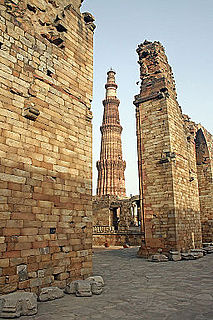
The Qutb complex are monuments and buildings from the Delhi Sultanate at Mehrauli in Delhi in India. Construction of the Qutub Minar "victory tower" in the complex, named after the religious figure Sufi Sant Khwaja Qutbuddin Bakhtiar Kaki, was begun by Qutb-ud-din Aibak, who later became the first Sultan of Delhi of the Mamluk dynasty. It was continued by his successor Iltutmish, and finally completed much later by Firoz Shah Tughlaq, a Sultan of Delhi from the Tughlaq dynasty (1320-1412) in 1368 AD. The Qubbat-ul-Islam Mosque, later corrupted into Quwwat-ul Islam, stands next to the Qutb Minar.

The Masjid e Jahan Numa, commonly known as the Jama Masjid of Delhi, is one of the largest mosques in India. It was built by the Mughal Emperor Shah Jahan between 1650 and 1656 at a cost of one million rupees, and was inaugurated by Imam Syed Abdul Ghafoor Shah Bukhari from Bukhara, present-day Uzbekistan. The mosque was completed in 1656 AD with three great gates and two 40 metres high minarets constructed with strips of red sandstone and white marble. The courtyard can accommodate more than 25,000 people. There are three domes on the terrace which are surrounded by the two minarets. On the floor, a total of 899 black borders are marked for worshippers. The architectural plan of Badshahi Masjid, built by Shah Jahan's son Aurangzeb at Lahore, Pakistan, is similar to the Jama Masjid.

The Jama Masjid is a mosque in the Kalbadevi neighborhood, near Crawford Market in the South Mumbai region of Mumbai, India.
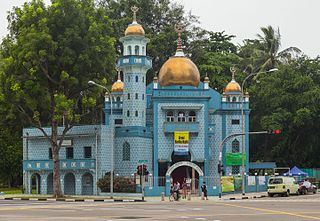
Masjid Malabar or Malabar Muslim Jama-Ath Mosque, also known as Golden Dome Mosque; is Singapore's only Malabar Muslim mosque. The mosque is located at the junction of Victoria Street and Jalan Sultan in the Kampong Glam district, in the Rochor Planning Area within the Central Area. The mosque is built on the Sultan Mosque style with traditional blue and white lapis lazuli tile facade. The mosque was nicknamed as little cousin of the Sultan Mosque, because of similar golden domes.

Jamia Masjid is a mosque in Srinagar, Jammu & Kashmir, India. Situated at Nowhatta in the middle of the Old City, the Mosque was commissioned by Sultan Sikandar in 1394 CE and completed in 1402 CE, at the behest of Mir Mohammad Hamadani, son of Mir Sayyid Ali Hamadani, and is regarded as one of the most important mosques in Kashmir. The architectural style of the Mosque is inspired by the Indo-Saracenic style of architecture, which is a blend of Indian and Mughal styles, and also bears similarities to Buddhist pagodas. The Mosque is located in Downtown which remains a central zone to the religio-political life in Srinagar. Thronged by Muslims every Friday, it is one of the prime tourist attractions of Srinagar.
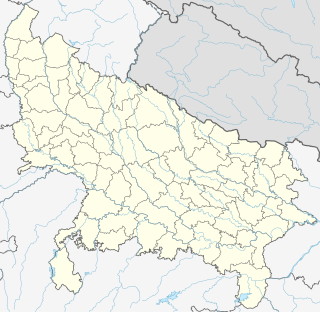
Saidpur is a town and a nagar panchayat in the Badaun district of the Indian state of Uttar Pradesh.
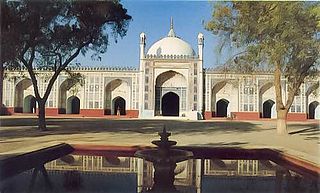
Eidgah or Idgah, also Eid Gah or Id Gah is a term used in South Asian Islamic culture for the open-air enclosure usually outside the city reserved for Eid prayers offered in the morning of Eid al-Fitr and Eid al-Adha. It is usually a public place that isn't used for prayers at other times of the year. On the day of Eid, the first thing Muslims do in the morning is gather usually at a large open ground and offer special prayers, in accordance with the Sunnah. Although the usage of the term Eidgah is of Indian origin, it may be used for the musalla, the open space outside a mosque, or other open grounds where Eid prayers are performed, due to the lack of a specific Islamic term for a site of Eid observance. The Eidgah is mentioned in the famous Bengali poem by Kazi Nazrul Islam, O Mon Romzaner Oi Rozar Sheshe.
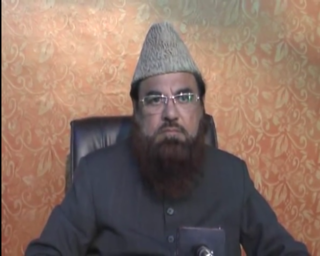
Mufti Mukarram Ahmed is an Indian Muslim religious and literary scholar. Ahmad is the Imam and Khateeb of Shahi Masjid Fatehpuri Mosque, India's second largest mosque.

Hallaur or Hallor village is located in Domariyaganj Tehsil of Siddharthnagar district in Uttar Pradesh, India. Domariyaganj is the nearest town to Hallaur village.

Atala Masjid or Atala Mosque is a 14th-century mosque in Jaunpur, Uttar Pradesh, India. It is one of the chief tourist attractions in Jaunpur.
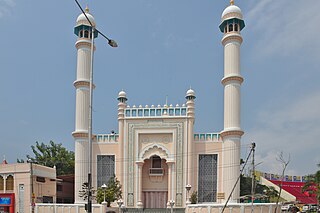
Masjid-i Jahān-Numā, commonly known as the Palayam Pally of Trivandrum, is the principal mosque of Trivandrum in Kerala, India. It is a Jama Masjid.
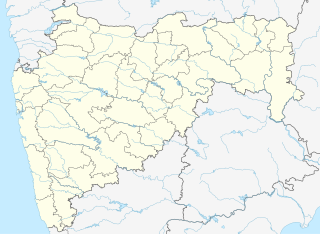
Kali is a village in the Yavatmal district of Maharashtra, India. It is named after Daulat Khan Patel. Kali (DK) is 20 km away from Pusad, which is to the east of Mahagaon. The population of Kali (DK) is around 10,000.
Shah-i-Deccan,Qutb-i-Konkan Khwaja Pir Hafiz Habib Ali Shah was born in a Sufi family, whose lineage is traced back to Abu Bakr, the first Caliph of Islam, his ancestors were Sufi masters. From Syedna Abu Bakr Siddiq, the forefathers of Pir Khaja Habib Ali Shah obtained the spiritual education (Tassawuf/Tariqat) and bestowed with Caliphat from their fathers
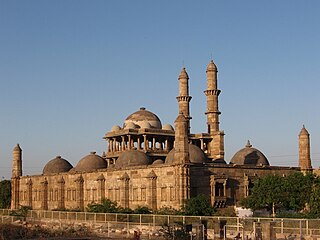
Jami Masjid in Champaner, Gujarat state, western India, is part of the Champaner-Pavagadh Archaeological Park, a UNESCO World Heritage Site, and is among the 114 monuments there which are listed by the Baroda Heritage Trust. It is located about 150 feet (46 m) east of the city walls (Jahdnpandh), near the east gate.
The Butt Road Jama Masjid is a mosque located in St Thomas Mount on the outskirts of Chennai, India. Situated at a distance of 13 kilometres from Chennai city and 2 kilometres from Guindy on the Mount-Poonamallee Road, the mosque caters to the Muslim population of the suburb and the nearby cantonment.

Athar Jamad Masjid is located at Oppanakara Street and Town Hall within the Coimbatore district of Tamil Nadu in India. One of the oldest and biggest masjid in Coimbatore. It is a living testimony of city's history.

Jama Mosque is one of the biggest mosque in Himachal Pradesh located in Kotwali Bazar, Dharamshala, India.
Masjid-e-Bilal is one of the largest mosques of Bangalore, Karnataka, India. It was inaugurated in mid-2015. The Turkish-style 'Masjid Eidgah Bilal' on Bannerghatta road was consecrated on 11 June. The mosque sits on the corner of a traffic intersection on a popular thoroughfare of southern part of the city. Prestige Group developers undertook the construction which began in 2010 and was completed recently. At that time was president of this committee from 2004 to 2015. The mosque constructed at a cost of Rs. 200,000,000 provides space for 6,500 people to pray at a time. A considerable portion of the cost was contributed by the Prestige Group.

The Jama Masjid commonly known as the Jama Masjid Rahmaniya, the oldest mosque in Rupandehi, Bhairahawa, Nepal. It is the largest and best known mosque in Rupandehi District of Nepal. It was completed in 1950 AD. This is one of the oldest mosque in Nepal.
Lucknow is a city of imambaras as it has a large number of imambaras among which are some very famous.















